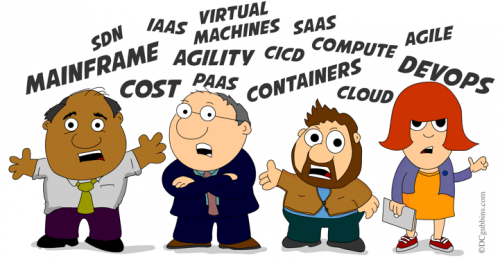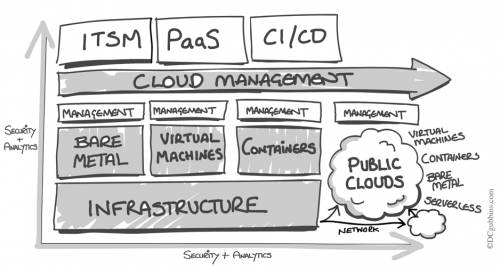
The demands on IT are growing rapidly. In many cases, they’re also seemingly conflicting:
“We need stability and agility.”
“We need to reduce risk but take more risks.”
“We are reducing the IT budget but spending on technology is going up.”
“We need to be open and avoid lock-in. Let’s put everything in AWS.”
I drew this diagram the other day to demonstrate the differing technologies and architectural decisions that need to be made when building next gen data centre and clouds.
It’s all pretty complicated. Especially when you start to get under the covers of how you would deliver the capabilities being demanded in a practical way.
Here’s 10 top of mind challenges for IT delivery today:
- Do I build net new or modernise what I have?
- Can I use a common infrastructure (Network, Compute, Storage) for all my bare metal, virtualised and containerised applications?
- Do I build technology silos? (ContainerService, IaaS, Virtualisation Service)
- Do I need to build a hybrid cloud?
- How do I network between multiple clouds and my data centres?
- Can a single vendor meet all or the majority of my requirements?
- Am I happy to be locked in anywhere?
- How do I enforce consistent policy and governance across all the existing and new environments?
- How do I secure all of this in a consistent manner?
- How do I make this cost effective?
Boiling this list down, we need to cater for the traditional stuff. Some of which needs modernising, but not with all the whizz bang speed and agility the newer stuff needs.
Gartner depicts the problem well with bimodal [yes I said it]. While you may or may not agree with bimodal it clearly highlights the challenges of a world of two-speed IT.
So, imagine I’m a CIO and rock up for work on Monday with all my department heads. What do they need?
 As you can see, they need a lot!
As you can see, they need a lot!
Here are a few principles for the discerning IT leaders and techies amongst you, who have to meet the demands of quite demanding customers.
What problem are you trying to solve?
Start with the problem and work back to the technology. The final solution should not be dictated by existing technology, people and process.
It’s about the service and not the location
To solve the business problem, we need to have a brokering mentality. It’s all about delivering the service and not worrying about where it’s being delivered from. It needs to be delivered from the best place for the service, be it data centre, private cloud or public cloud. To achieve this though, you will need a brokering capability, whether that be a cloud management platform or a federated PaaS or something else.
Not one ring to rule them all
As techies, we tend to start from the bottom up and look at delivering a great technical stack that will address all eventualities. On paper, it seems engineering a single stack with all manner of bells and whistles is the answer. However, that approach is unlikely to work. Things are changing at an unprecedented rate. By the time you’ve built your super-duper private cloud/next gen data centre/full stack thing, the world will have moved on. Yes, you will need to build some of these yourself. Equally you will consume them from other providers.
Build an Ecosystem
In order to consume multiple services, you need a broad ecosystem. With respect to cloud providers, some will offer bespoke capabilities that meet the specific requirements of a given service. Others will be generic and should be consumed as a commodity. With respect to the technology, different vendors will supply value at different points in the stack.
I can’t keep up
If you’ve built a private cloud but you can’t innovate as fast as public cloud don’t worry. You don’t have to. That’s why they’re there. Your private cloud provides a specific set of capabilities: “A very particular set of skills. Skills you have acquired over a very long career!” [See what I did there? J] For services that don’t need your private cloud capabilities stick them in public.
Lock in
This is an interesting one. The industry loves being open and hates the idea of vendor lock-in. Which is fine, but unless you are going to go all open source and employ an army of experts to deliver and support your open source goodness, then you will no doubt be forced to consume some proprietary solutions within your stack. That could be a cloud provider like AWS or Azure. It could be a PaaS solution like Pivotal, or a Cloud Management Platform like Cisco CloudCenter. It all comes down to risk and value.
IT is hard nowadays
IT has always been hard. In trying to meet the growing demands of the traditional and the digital it’s getting even harder. I’ve not given you any real answers, just some things to consider. Watch this space and in future posts we’ll delve under the covers and look a little deeper into the stack components, choices and risks involved.
1 Comments



…Sounds like they need to speak to Nutanix 🙂